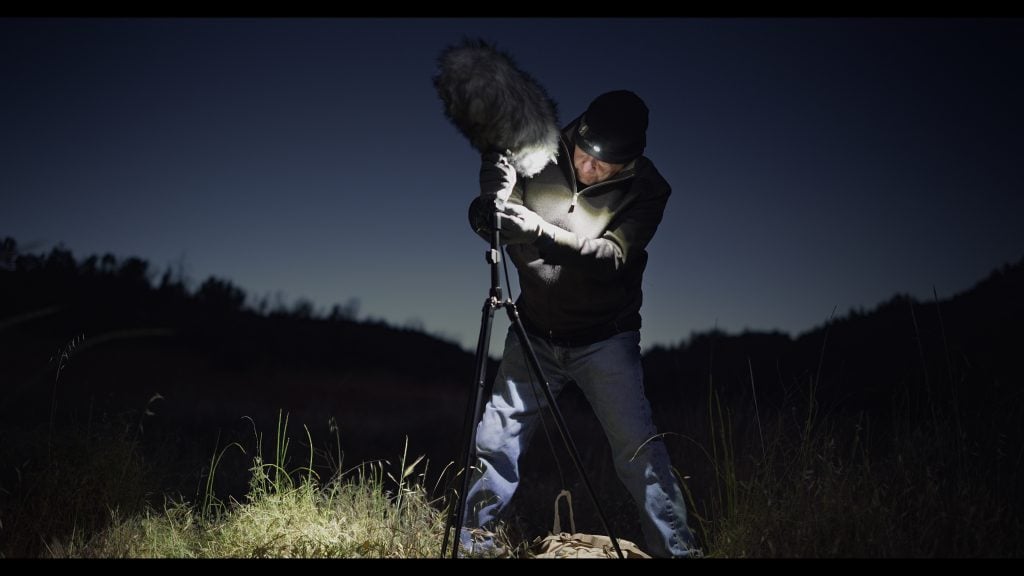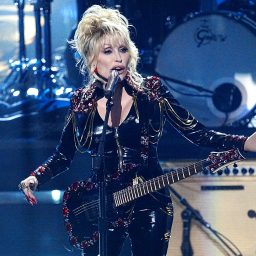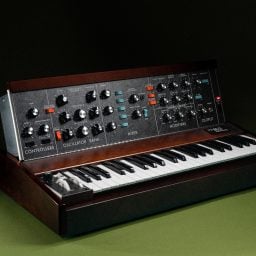In the late 1960s, Bernie Krause was at the top of his game as a musician, sound designer, and master of the Moog synthesizer, recording with the likes of Van Morrison, George Harrison, Mick Jagger, Brian Eno, and The Doors, while working on films such as Apocalypse Now. Then, he gave it all up and went wild—literally.
Krause has been exploring the natural world as a pioneering soundscape ecologist ever since. And his masterpiece—“The Great Animal Orchestra” (November 20–May 22, 2022), originally commissioned by Paris’s Fondation Cartier pour l’art contemporain in 2016—is about to have its North American premiere at the Peabody Essex Museum in Salem, Massachusetts (before traveling to Sydney, Australia and elsewhere next year).
The exhibition is based on 5,000 hours of Krause’s field recordings from the past 50 years, featuring 15,000 terrestrial and marine species from around the globe—many of them since lost or currently at risk. With the soundscapes reinterpreted as large-scale, animated spectrograms by the London-based collective United Visual Artists, it is an immersive and highly moving experience of the ever-vulnerable sound universe.
Krause is meanwhile the subject of a new Cartier Foundation–produced documentary directed by the French filmmaker Vincent Tricon, which will be shown as part of the Peabody’s presentation. Just before the opening, he connected with Artnet News about the show, his creative transformation, and art’s role in preserving the natural world.
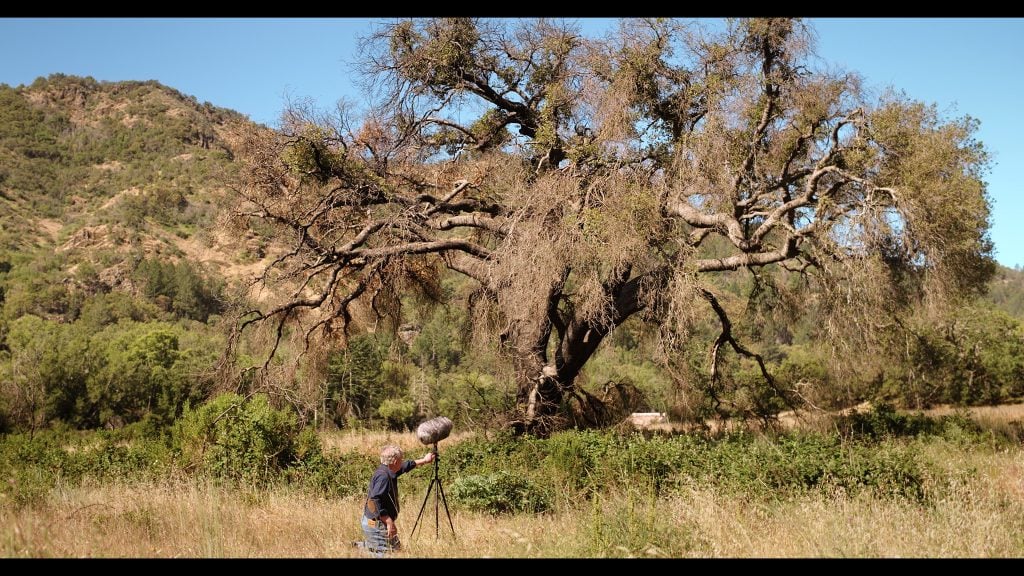
Krause at work. Bernie Krause, 2021 © Masha Karpoukhina for Fondation Cartier pour l’art contemporain.
What inspired you to move on from your life as a musician to explore the natural world as a soundscape ecologist? What are the biggest differences—and perhaps similarities—between your lives then versus now?
Paul Beaver, my late music partner, and I got invited to record with some awesome artists and groups [in the late 1960s]. But when it got to the point where we were being asked to replicate the sounds produced on previous sessions, something inside snapped—I found myself staring at the padded, windowless walls of studios in L.A., London, and New York, with mixed feelings of terror, boredom, and immobility. It was at that point that I began looking for an escape. Music, in my disordered state of mind, had become nothing more than a self-referential echo of our own limitations.
As it happened, Paul and I had just been signed by Warner Brothers to do three albums. For our own mental health, we sought to produce something thematic that hadn’t been tried before and where we could explore some of the Moog’s performance options we hadn’t shared with other artists. Our initial album, titled In a Wild Sanctuary, centered on the theme of ecology, and natural soundscapes [were] a main constituent of the orchestration. We needed a quiet rural area or wild forest in which to record.
I didn’t go terribly far to secure those early recordings—just across San Francisco’s Golden Gate Bridge to a small park in Marin. But when I cranked up my new stereo recorder and heard the numinous impression of a nearby stream, the illusion of larger-than-life sonic space, the edge-tones of a pair of ravens’ wingbeats as they cut an arc across the sky overhead, and a gentle sea breeze in the redwood canopy wafting in from the Pacific to my west, something inside me instantly changed. I felt relaxed and present in the living world and amazingly free of anxiety.
I had discovered for myself a new sense of being and felt obliged to go wherever that reaction took me. I was 30 years old then. I’ve pursued a replay of that moment’s impact ever since.
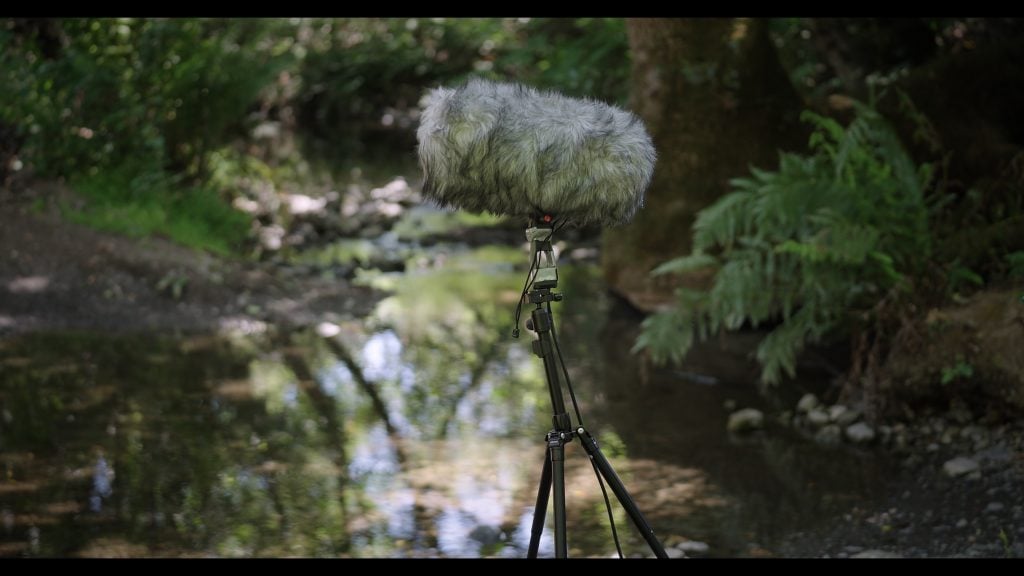
Out in the field, Krause records dawn, midday, dusk, and nighttime choruses. Bernie Krause, 2021 © Masha Karpoukhina for Fondation Cartier pour l’art contemporain.
I’d love to hear about your creative process as a soundscape ecologist.
I begin by finding habitats that are relatively untouched by human endeavor. Then I identify a local naturalist or biologist that knows intimate details of the area [and its] unique wildlife [to] help facilitate my time on site. But for the most part, I prefer to work alone.
Over the course of a 24-hour day, I’ll likely record four two-hour sessions: a dawn chorus, a midday chorus, dusk and nighttime choruses, times when biophonies are likely at their peak. [These are] the collective sounds coming from all organisms in a given habitat at one moment in time.
When I return to the studio, the first thing I do is transfer all of the field data related to that recording into my archive. Then I have two basic avenues of expression. The first, through science, is to write and publish a paper related to what I’ve observed given what the data show. The problem with that avenue is that very few people read this literature.
If I want to reach a much larger audience, I turn to the arts, transforming the data into programs that are widely accessible and emotionally evocative while at the same time keeping the integrity of the message firmly intact.
Paris’s Cartier Foundation originally commissioned “The Great Animal Orchestra” in 2016, and it is now part of the permanent collection. What’s the backstory of the commission, and how did the idea come about?
I had written and released a book, The Great Animal Orchestra: Finding the Origins of Music in the World’s Wild Places—basically the story of how we learned to sing, dance, and speak from mimicking the voices of the natural world. [It] was translated into seven languages, one of which was French. Somehow, a French anthropologist, Bruce Albert, who has been working with the Yanomami tribe in northern Brazil for decades, found a copy and gave one to his good friend, Hervé Chandès, director of the foundation. After reading it, Hervé contacted me in 2014 proposing that I take some of the raw field data and transform them into large-scale sonic art pieces.
A few months later, Hervé came to visit my wife, Katherine, and me at Wild Sanctuary, our home in northern California. Over the course of a few intense days, we auditioned the soundscapes of many habitats, whittling them down to a couple of dozen. From those, I proposed a selection of 15 or 16 habitat recordings to choose from. With the field recordings from those selections, I began the transformation process, taking raw material representing each location, assembling and mixing the various segments and generating a seamless acoustic narrative that I felt would capture and evoke the essence of each unique biome.
And because most of what we observe of the living world has been through what we see, we decided to include a visual component—one that illuminated the soundscapes.
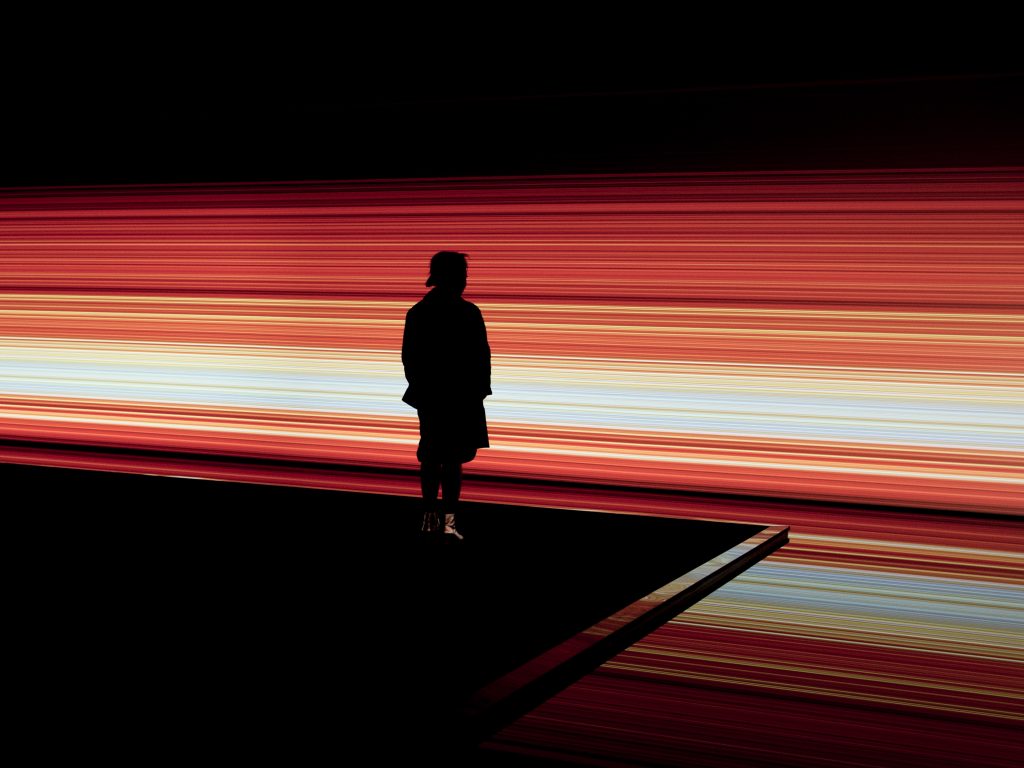
For “The Great Animal Orchestra,” London’s United Visual Artists (UVA) re-interpreted Krause’s soundscapes as large-scale spectrograms. Courtesy of Fondation Cartier pour l’art contemporain.
I understand that you collaborated with United Visual Artists (UVA) to interpret them as animated spectrograms—immersive, graphic illustrations of sound.
Having worked with that technology since the late 1970s when it was still in a primitive form, I knew its potential. From my work with them in small, limited formats, I was able to illustrate axiomatically that if the habitats they represented were healthy, that condition [would] show in the structured detail of the spectrograms. Conversely, if the habitats are under stress, then the spectrogram images will appear to be chaotic and incoherent.
With the expertise and insight of Matt Clark and his team at UVA, the problem of converting those sounds into instantaneous streaming spectrograms was solved. [They developed] proprietary software [and] expanded these images into spectacular large-format pieces, [which] I could not have imagined when I began working on this project.
Out of all 5,000 hours of your research and field recordings leading up “The Great Animal Orchestra,” which soundscape has made the deepest impression on you?
The place I return to the most, both physically and when listening to replays of my archive, is Alaska, and, in particular, the Yukon Delta. Each spring, late in the season, millions of birds from places as far away as New Zealand and South Africa converge in this one biome to breed, feed, and rest for a couple of months before heading south on their respective return journeys. It’s the most life-affirming sound I know of, urgent and compelling, crying out for us to pay some serious attention lest it disappear suddenly and altogether. With the advent of global heating, the Delta, too, is under threat from melting tundra—most obvious given the thawing terrain always under foot.
Are there any particularly unusual moments from your fieldwork?
One that sticks in mind is the first time I heard ants singing in the American southwest desert. With my colleague Phil Aaberg, I was recording a journey following spring as it moved north 43 miles a day along the 111 Meridian from Nogales, to the Canadian border. Several First Nations groups living along that route had used it for their vision quests.
At one campsite in Arizona slickrock country, I dropped a small lavalier microphone onto the entrance of an ant’s nest. The tiny critters immediately gathered around the intruding object and physically tried to remove it; the leader [was] furiously stridulating, rubbing its hind legs on its abdomen, and sending out high-pitched signals that I managed to record.
It isn’t the large organisms that surprise me as much as the ones we can barely see. One researcher in the UK has even recorded the sound signature of a virus.
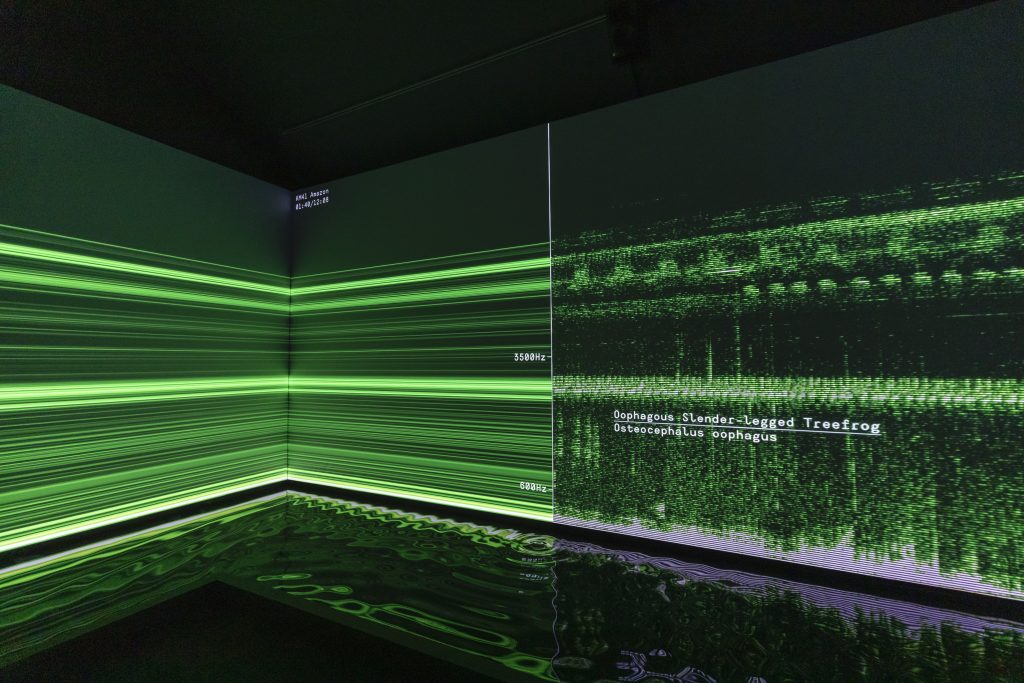
At the Peabody Essex Museum, UVA’s spectrograms detail when and where Krause recorded his soundscapes. Photo: Kathy Tarantola.
You’ve returned to the sites where you recorded soundscapes in the 1970s—across North America, Latin America, Kenya, Rwanda, and Zimbabwe, and also from the depths of the oceans—to find that more than 50 percent of the biodiversity you’d recorded has been lost. Have you revisited any of these sites since the pandemic, and if so, have you heard anything surprising?
I haven’t traveled much in the past two years. At my age—83—I take fewer risks. So, except for local recording spots, I haven’t done much in the adventure department. It has become a bit more difficult to crawl in and out of tents. [But] my wife, Katherine, and I will be returning to Africa sometime next year if all pans out.
I’ve only re-visited five sites, most of which were recorded in the past 30 years. Four of [them] are terrestrial; one is marine. For the latter, I recorded the same coral reef with both living and dying segments for comparison. All [are] featured in the Peabody Essex Museum exhibition, by the way—you can hear and see the biophonic changes in these habitats, in less than a minute.
Is it true that “nature is healing,” as they say, and if so, what does that sound like?
One thing I did notice: when COVID first hit, in March 2020, the spring biophony everywhere was particularly gorgeous, with amazingly positive reports from Europe and large cities here in the U.S. That was because there was a lot less noise masking the resonant biophonies that always try to make themselves heard above the din we create. Folks [heard] birds they’d never heard before.
How has this last year and a half impacted you creatively?
Over the past 18 months, I produced six new albums, yet to be released. One is of soundscapes drawn from Jane Goodall’s Tanzanian research site, Gombe. It is an album I’ve wanted to release since I recorded it with my colleague Ruth Happel some 30 years ago, but never had the time to finish. We’ve licensed that title to the Jane Goodall Institute to help raise funding for her ongoing efforts to save chimpanzee habitats.
Frankly, I loved the respite. I never once watched the news—the noise was too debilitating.
You also published a new book, The Power of Tranquility in a Very Noisy World. What do you listen to when you need to relax?
There are a number of soundscapes I turn to: rhythmic ocean waves, rain and distant thunder, gentle desert wind with a few bird vocalizations—like the melodious expressions of meadowlarks. And summer evening soundscapes from the east and west coasts of North America, to name a few.
What is your biggest hope for “The Great Animal Orchestra”?
While it has been shown extensively in [Europe] and Asia—it’s been heard and seen by over one million visitors so far—this is a first for American audiences. These biophonies represent the eloquent voices of the natural world. No one who hears [them] is left unaffected. The best takeaway would be that visitors will feel a loving connection to the living universe in ways that inspire them to protect the habitats that still thrive, and to help restore those that are failing.
Follow Artnet News on Facebook:
Want to stay ahead of the art world? Subscribe to our newsletter to get the breaking news, eye-opening interviews, and incisive critical takes that drive the conversation forward.
